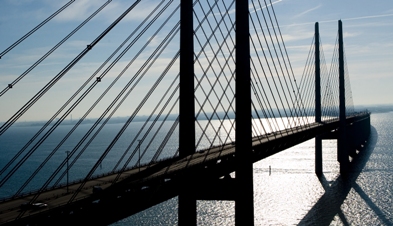Article No. 13
Industrial Ph.D. Project (May 2010 - April 2013)
Student: Giulia Matteoni
Supervisor(s): Christos T. Georgakis;
Holger H. Koss
Industry Partner: IPU
Summary
Through a greater openness between owners and engineers and an improved level of awareness, it has become increasingly apparent that a large number of the world’s long-span bridges suffer from some form of cable vibration. Characteristic examples of bridges with large amplitude cable vibrations include the Øresund Crossing (Figure 1), Storebælt Bridge, First and Second Severn Crossings, the Humber Bridge and the Fred Hartman Bridge - to name a few. Several cable excitation mechanisms have been identified and fair level of research towards comprehending these has been undertaken.

Figure.1 Øresund Bridge, between Denmark and Sweden.
Excitation mechanisms are currently broadly grouped into two forms: those attributable to the wind and those which are the consequence of some other form of end loading, i.e. structurally induced. Of the wind induced mechanisms, those involving rain and/or ice seem to generate the largest cable vibration amplitudes [1]. Nevertheless, there is still no definitive understanding and description of these excitation mechanisms. Attempts to model these vibrations have been met with varying degrees of success. To date, no ultimately successful wind-structure interaction model has been devised for tall or long structures under all meteorological conditions. This is most likely due to the fact that the observed structural vibrations are a result of wind flow, which is not well defined [2]. Another reason is that the flow around a cable – particularly when inclined – is only partially understood [3]. Testing of cables under controlled conditions is crucial in this respect.
The objective of the proposed research is the comprehensive understanding and simulation of bridge cable vibrations under the most prevalent meteorological conditions in Scandinavia.
To achieve this an in-depth literature review of the state-of-the-art in the field, with a database of significant works, is first compiled. Then, a characterization of existing cable vibration mechanisms will be made, and the scientific knowledge associated with each mechanism evaluated. Wind-tunnel investigations of a full-scale dry and iced/sleeted cable section will then be undertaken for varying wind conditions and angles of attack. The tests shall be separated into categories according to cable surface configuration, i.e. dry, ice or sleet. The tests will be performed for both turbulent and laminar flow. Based on the preliminary processing of this data, further testing at specific wind velocities and angles may be proposed. A detailed interpretation of the wind-tunnel test data will help create a clearer understanding of several of the more dominant excitation mechanisms. The ultimate goal of this will be the creation of appropriate wind loading models, to be used for the calculation of cable response to wind.
Verification of the loading models shall be made by comparing theoretically predicted cable vibrations to the measured responses of actual cables.
References related to this Research Project:
[1] H. Gjelstrup, C.T. Georgakis, A. Larsen “A Preliminary Investigation of the Hanger Vibrations on the Great Belt East Bridge”, 7th International Conference on Cable Dynamics, 10-12 December, 2007, Vienna
[2] Ferawati Gani, Louis-Philippe Parent, Frédéric Légeron, Stoyan Stoyanoff, and Pierre Van Dyke, “Three-Dimensional Wind Correlation: Estimations from In Situ Measurements”, ASCE Structures Congress 09’, Austin, Texas, May 2009
[3] Tomomi Yagi, Hiroko Naito, Zifeng Liang, Hiromichi Shirato, “Evaluation of Aerodynamic Forces on anInclined Cable in Consideration of End Conditions of Model for Wind Tunnel Tests”, 8th International Symposium on Cable Dynamics, 20-23 September, 2009, Paris, France
Ongoing Research Work:
Related Publications:
Matteoni, G., Georgakis, C.T., "Effects of bridge cable surface roughness and cross-sectional distortion on aerodynamic force coefficients", Proceedings of the 13th International Conference on Wind Engineering,
Amsterdam, the Netherlands, 10-15 July 2011.
Matteoni, G., Georgakis, C.T., "Aerodynamic coefficients of dry inclined cables in smooth flow", Proceedings of the International Symposium on Cable Dynamics, 18-20 October 2011, Shanghai, China.